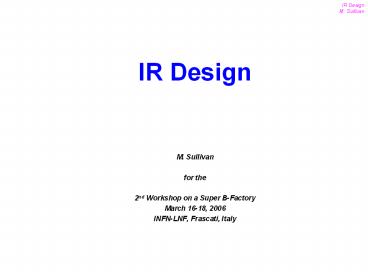M.%20Sullivan - PowerPoint PPT Presentation
Title:
M.%20Sullivan
Description:
Andrei's MAD deck. Pantaleo's novel idea. Beam pipe and magnet apertures. SR fans ... Used a MAD deck from Andrei to get started. Magnet strengths. Magnet positions ... – PowerPoint PPT presentation
Number of Views:17
Avg rating:3.0/5.0
Title: M.%20Sullivan
1
IR Design
- M. Sullivan
- for the
- 2nd Workshop on a Super B-Factory
- March 16-18, 2006
- INFN-LNF, Frascati, Italy
2
Outline
- Starting point
- ILC style design
- Beam parameters
- Design considerations
- Andreis MAD deck
- Pantaleos novel idea
- Beam pipe and magnet apertures
- SR fans
- First attempt at a design
- Still to do
- Summary
3
ILC type collision
- Very small spot sizes
- Large crossing angle
- Small emittances
- Large beta functions
4
Parameters from Pantaleos presentation
- Optimized flat case in multi-turn regime
with Np21010, - Nbunches5000 (3Km ring), Colliding every
turn - IP parameters
- sigx2.67um sigy12.6nm Crab focus on in
vertical plane - betx2.5mm bety80um
- X_crossing_angle225mrad
- sigz4mm sige5MeV (sige/e110-3)
(Lum_sige7MeV) - emix0.4nm (emix_norm4um)
- emiy0.002nm (emiy_norm20pm)
- emiz4.0um
- Damping_time (Tau)10msec
- Stored time between collision10usec0.001Ta
u1turn - Collision_frequency100KHz5000
- Lmultiturn0.81036 (Lsingleturn1.2103
6) - Vertical tune shift like in PEP!!! (similar
currents,100 times - more luminosity, 100 times smaller betay)
5
Some IP Parameters
- HER LER
- Beta x (mm) 2.5 2.5
- Beta y (mm) 0.08 0.08
- Emittance x (nm-rad) 0.4 0.4
- Emittance y (nm-rad) 0.002 0.002
- Sigma x (?m) 2.67 2.67
- Sigma y (?m) 0.0126 0.0126
- Bunch spacing (m) 0.6
- Crossing angle (mrad) 25
- Luminosity 0.8?1036
6
Design Considerations
- Used a MAD deck from Andrei to get started
- Magnet strengths
- Magnet positions
- The quad closest to the IP is shared
- Pantas idea is to use a shared sextupole as well
- The beams are off axis in the sextupole
- The shared quad and sextupole have to have a
large enough apertures to accommodate both beams - The SR fans have to be followed
7
Shared sextupole
- The shared quadrupole has to be optimized for the
incoming beam - This means the outgoing beam (which has a
different energy) is getting either too little or
too much focusing - Enter the shared sextupole
- With a shared sextupole and with the beams
separated the sextupole introduces a quadrupole
term to each beam that is opposite in sign - This allows us to add quad strength to the HER
and at the same time subtract quad strength from
the LER - And vice versa on the other side of the IP
- Several possibilities exist
- Incoming beams on axis with the sextupole,
outgoing beams off axis - Sextupole axis between the two beam trajectories
- Caveat The beam focusing is dependent on the
beam orbit
8
First attempt at a design
- Crossing angle of 50 mrad total (25 mrad)
- Beam energies of 4 and 7 GeV
- Separate beam pipes at 2.25 m in front of the
second quad - The beta functions are presently not well matched
to any sort of transport lines - Put the shared quad and shared sextupole on the
same axis between the two beams (0 deg in the
picture) - The shared quad (QD0) together with the crossing
angle separate the 2 beams
9
(No Transcript)
10
Layout of IR orbits for ILC version Super B
Factory
11
(No Transcript)
12
(No Transcript)
13
More to do
- More back and forth with the optics people
- Trace out the SR fans make sure they do not fry
the IP beam pipe - Trace out the SR from the focusing elements for
detector bkgd masking - Radiative Bhabhas. Where do they go?
- Beam-gas bkgds
- Find minimum radius beam pipe for IP probably
needs water cooling - HOM power
14
Summary
- Coming from the ILC design is an interesting
approach - Shared sextupole allows for a better optics match
between the different beam energies - Large crossing angle helps to separate the beams
- Very preliminary first look shows promise










![get [PDF] Download Workbook for 10x Is Easier Than 2x By Dan Sullivan & Benjamin Hardy: Ex PowerPoint PPT Presentation](https://s3.amazonaws.com/images.powershow.com/10120532.th0.jpg?_=202409051212)
![get [PDF] Download Workbook for 10x Is Easier Than 2x By Dan Sullivan & Benjamin Hardy: Ex PowerPoint PPT Presentation](https://s3.amazonaws.com/images.powershow.com/10102724.th0.jpg?_=20240820039)
![get [PDF] Download Workbook for 10x Is Easier Than 2x By Dan Sullivan & Benjamin Hardy: Ex PowerPoint PPT Presentation](https://s3.amazonaws.com/images.powershow.com/10100572.th0.jpg?_=20240816117)


















